In the digital age, the significance of digital security has reached unprecedented heights. As cyber threats evolve and become more sophisticated, traditional security measures are increasingly falling short. Enter the dynamic duo of Artificial Intelligence (AI) and Machine Learning (ML), poised to redefine the paradigms of digital defense.
The AI Revolution in Folder Security
The digital realm is witnessing an exponential growth in cyber threats. These threats are not only increasing in number but also in their level of sophistication. This evolution demands a new breed of advanced defenses, and AI is stepping up to the challenge. Offering innovative solutions that go beyond the scope of traditional digital security, AI is a game-changer.
AI is dynamic. It has the unique ability to adapt and evolve in real-time, consistently refining its threat detection algorithms. This ensures that it stays several steps ahead of cybercriminals, who are always on the lookout for new vulnerabilities.
AI’s unparalleled analytical capabilities allow it to process and analyze vast datasets in a fraction of the time a human would take. It delves deep into user behavior patterns, file access routines, and intricate network activities. This meticulous analysis enables AI to detect even the most subtle anomalies, offering businesses strategic advantages in data security.

AI-Powered Threat Identification
In the vast landscape of digital security, AI stands out as the ultimate detective. Equipped with unmatched analytical prowess, AI algorithms can swiftly and accurately identify threats that often remain hidden from conventional security measures.
Imagine AI as a relentless investigator, tirelessly sifting through vast datasets within your folders. It leaves no stone unturned, examining every user behavior, scrutinizing each file access pattern, and dissecting all network activities. This level of scrutiny surpasses human capabilities, ensuring that with AI, cyber threats have nowhere to hide.
Understanding Anomaly Detection
Machine Learning, a powerful subset of AI, is making waves in the realm of anomaly detection. Anomalies can be seen as deviations from the normal patterns of behavior within folders. While some are glaringly obvious, others are incredibly discreet, almost imperceptible to the human eye. This is where ML models come into play.
By continuously analyzing historical data, these algorithms develop a keen sense of what’s considered “normal.” More importantly, they can identify what’s not. But the capabilities of ML don’t end at mere anomaly detection. It takes security a step further with its predictive power. By studying past data, ML can forecast potential anomalies and threats, allowing businesses to take proactive measures.
Adaptive Learning for Folder Security
In the ever-changing world of cyber threats, static defenses are inadequate. Enter adaptive learning, where ML algorithms constantly evolve to counteract new threats. These digital chameleons change and adapt, ensuring that security measures remain effective regardless of how threats evolve. This isn’t just a minor upgrade; it’s a monumental shift in how we approach security.
Historically, digital security has been reactive, often addressing breaches after the damage is done. However, with the integration of AI and ML, there’s a significant shift towards proactive security measures. Predictive models, powered by AI, can simulate a myriad of attack scenarios. From brute force attacks to stealthy infiltrations, these models highlight potential weak points, allowing organizations to bolster their defenses.

Integrating AI-Driven Security
The future of folder security is intertwined with AI. To fully harness its potential, businesses should:
- AI as the Cornerstone: Recognize and embrace AI’s transformative potential.
- Cloud Security Reinvented: Extend AI’s capabilities to cloud storage, ensuring data remains secure regardless of its location.
- Empowering Your Team: Equip your team with the knowledge and tools to collaborate effectively with AI-driven security measures.
- Strategic Planning: Transitioning to AI-driven security is a journey that requires careful planning and strategy.
- Collaboration, Not Replacement: AI is here to enhance, not replace. It should work alongside your team, amplifying their capabilities.
Securing the Human Element
Despite the prodigious advancements enabled by AI and ML in digital security, it is imperative to underline the ongoing relevance of the human element in this context. Cybersecurity isn’t merely a technological challenge but a human one, too. Even with the most advanced AI-driven security protocols, the vulnerabilities often lie in human errors and oversight. Phishing attacks and social engineering tactics, which exploit human weaknesses rather than technological loopholes, remain among the most prevalent cybersecurity threats.
In the impending era, the synergy between technological advancements and informed, vigilant human users will be paramount in devising a formidable defense against cyber threats. The implementation of AI and ML should thus be complemented with comprehensive training and awareness programs for all users, from top-level executives to entry-level employees. A culture of cybersecurity consciousness, where individuals are not only aware of the threats but also empowered with the knowledge to counteract them, becomes indispensable.
Moreover, ethics and regulations will play a pivotal role as AI and ML continue to permeate folder security protocols. The balance between stringent security and preserving user privacy needs to be meticulously maintained. Regulations should be formulated and adhered to, ensuring that while AI vigilantly monitors and secures data, it doesn’t infringe upon user privacy and complies with data protection laws.
In this equilibrium, AI and ML serve as technological sentinels, safeguarding digital assets, while enlightened and cautious human users act as the first line of defense against threats that technology might not instantaneously recognize. As we sail through the digital age, it’s this alliance of technological prowess and human sagacity that will forge an impervious shield against the burgeoning tide of cyber threats.

Conclusion
In the face of evolving digital threats, AI and ML stand as pillars of modern data security. Their roles in threat detection, anomaly identification, and predictive modeling are invaluable. As we navigate the digital future, these technologies will be our guiding lights, ensuring our data remains secure. Embrace them, and fortify your digital assets against looming cyber threats.
In addition, the harmonization of technological advancements and robust human cybersecurity awareness presents a multifaceted defense, further safeguarding our digital domains from potential breaches. Nurturing a collaborative environment where technology and human insight coalesce enhances our ability to preemptively identify and mitigate evolving cyber threats. Thus, while AI and ML sculpt the future of cybersecurity, the symbiosis of tech-savvy and vigilant human users fortifies and enriches this future, ensuring a resilient, adaptive, and comprehensive digital safeguard.





![Calgary’s Hottest Neighborhoods for Luxury Homebuyers [2024]](https://thewashingtonote.com/wp-content/uploads/2024/04/Calgary-324x160.png)



